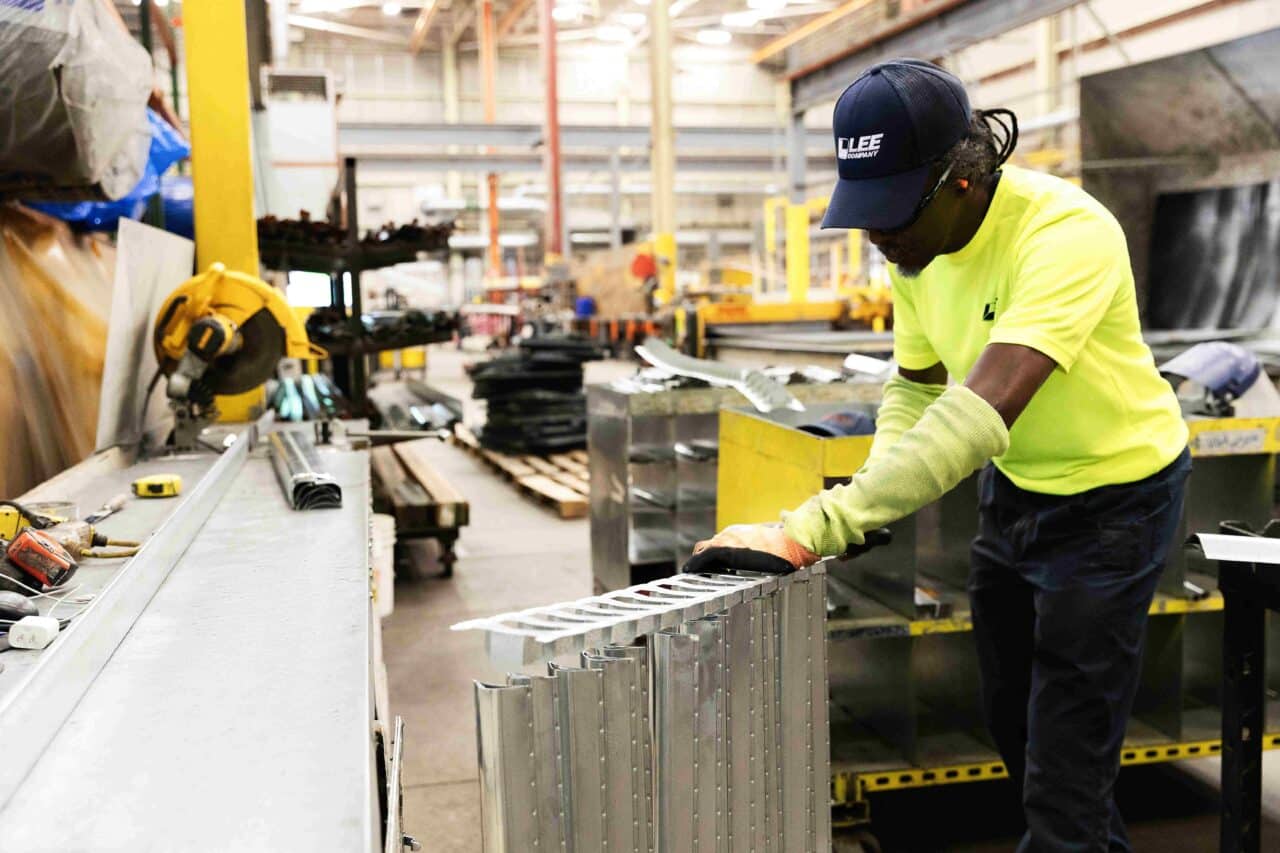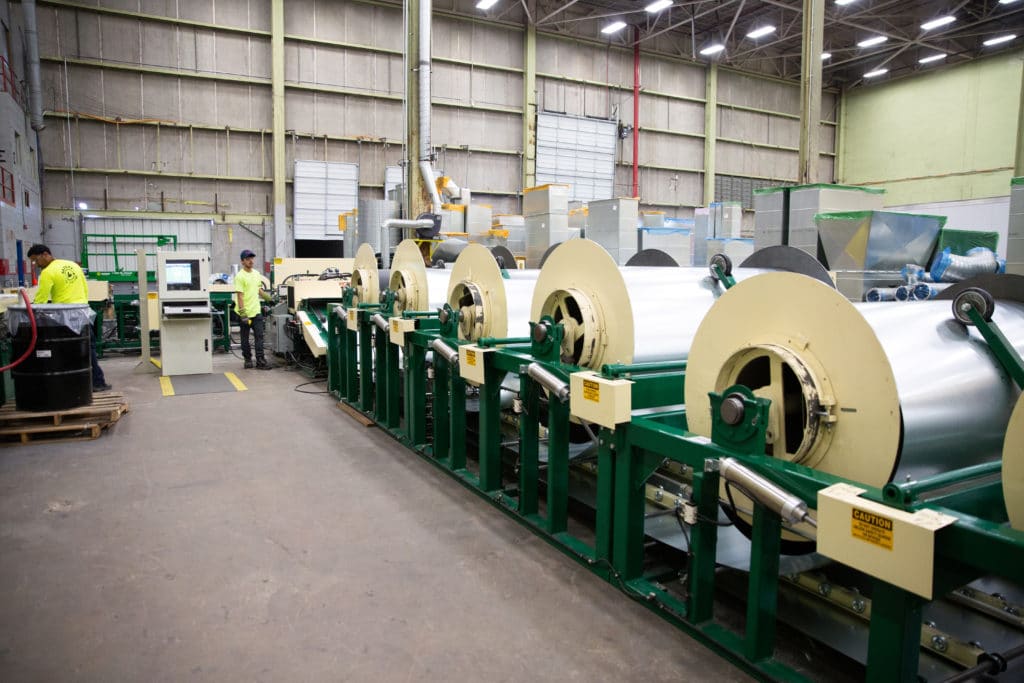Traditionally, the construction industry has been somewhat slow to change. Fortunately, today that reluctance is changing. As the advantages of new construction technologies become increasingly apparent, innovation is far more appealing to everyone from owners/clients to general contractors to tradesmen on the job site.
Lee Company, long recognized as an industry leader, embraced building information modeling (BIM) and virtual construction early on. Our expansive fabrication shop runs nearly around the clock, producing customized materials that simplify on-site construction. In addition to prefabricating ductwork and other materials, our fab shop team now assembles entire skids, such as bathroom batteries, sized and ready for fast, easy installation.
The need for such prefab and modular construction becomes more obvious every day. With an industry-wide labor shortage and other circumstances beyond our control – everything from weather to COVID-19 – it’s simply not efficient or economical to stick-build everything these days.
And, there’s no reason to stick-build everything. Technology improves the construction process and product. Using technology to move projects from design through delivery – tying together Building Information Modeling (BIM), fabrication, and building – involves:
- Obtaining manufacturing data
- Importing the data and designing a model
- Creating modular pieces
- Coordinating all the trades
- Delivering materials to the job site
At Lee Company, even when we’re not providing full design/build services, we use whatever technology is relevant to the job, from conducting 3D scans to looking at installation through augmented reality glasses. Technology is now part of our day-to-day toolkit, and the advantages it brings are plentiful.
Top 5 Advantages of Prefab and Modular Construction
1. Improved Productivity and Quality
Working in the controlled manufacturing environment of a fab shop, with access to more automated equipment and no weather issues, leads to improved productivity and quality. For example, the Lee Company fabrication shop includes automated welders, plasma tables, and cutting machines. It’s far simpler to take a BIM-generated cut list and optimize cuts when your work is supported by state-of-the-art equipment – and that equipment is never out in the snow or rain or blazing heat.
The manufacturing environment also empowers expanded training opportunities and quality control. Construction professionals on a job site typically need a broad range of skills. In the fab shop, employees learn various processes in manufacturing and quality control, and then typically focus their work on one area. Their environment is clean and controlled – and so is their work.
The fab shop also opens career prospects and job opportunities for construction professionals. Over the past three years, the number of employees in the Lee Company fab shop has tripled. The extensive training these employees receive helps them understand all the processes and systems used, and the level of detail involved in the manufacturing process. That understanding, in turn, leads to improved productivity and quality.
2. Schedule Certainty
When it comes to working with prefab and modular construction, one of the most important benefits to owners and general contractors is schedule certainty – and that plays out in several areas.
For example, advanced work conducted in the controlled manufacturing environment eliminates the time-draining issue of running out of material on the job site, just when that material is needed. Supply chain issues, RFI responses, and labor schedules are all simplified.
In addition, the number of available, skilled, experienced tradesmen is falling; as older construction workers retire, they are not being replaced in equal numbers. It can be challenging to find highly skilled tradesmen when you need them. With prefabricated materials, installation schedules are well-planned in advance, so the crew is on-site when needed and ready to go.
As another (and very practical) example, imagine the construction site for a multi-story building. There’s one service elevator. Getting materials where they’re needed, when they’re needed, requires working with the other contractors and scheduling delivery – and elevator – times. When complete skids are packaged and delivered, the logistics are easier to plan, and moving the material takes less time. It’s a boon for scheduling and for project teamwork – other contractors appreciate the efficiency.
And, of course, work doesn’t have to stop for downpours, tornados, snowstorms, or any kind of inclement weather.
3. Cost Predictability
Lee Company recently handled a nearly $5 million design/build project for a North Alabama manufacturing facility. With ceilings 60 feet high, the typical route for piping the facility would have been very expensive. Lee Company reviewed designs, budgets, and options, and then suggested prefabricating racks to hold all the mechanical and plumbing.
After receiving client approval, Lee Company used a 3D scanner to guide the initial work. The technology paid off immediately: The structural engineer’s measurements on columns were off by about 6-8 inches – and there was no room for that kind of error. With accurate info in hand, the fab shop was able to quickly prefabricate the pipe racks, and Lee Company installed roughly 3,000 feet of pipe in the first week.
Can you imagine what the costs would have been if all the racks were wrong? Can you imagine the time lost? And, in the construction world, time is definitely money.
Virtual construction does more than reduce errors; it finds efficiencies. Pre-planning with BIM and prefabricated models helps control costs. When designs need to be clarified, that work is done upfront, not in the middle of the project at the construction site – where changes create costly delays.
4. Reduced Waste
A construction site is a huge waste generator. With large builds, mounds of construction debris are typically hauled off to a landfill. On the flip side, we’ve found that waste in the controlled manufacturing environment of a fab shop is typically less than 5 percent.
Cut optimization provides an excellent example of how waste is reduced with prefab and modular construction. Automated equipment optimizes cuts and reduces scrap; a 20-foot stick of copper pipe can easily be cut into precisely measured sections, whether what’s needed is a 10-foot pipe or something smaller.
Along with the obvious environmental benefits, waste reduction on the job site pays off in a number of areas, including cost savings and safety. Reduced debris = reduced trip hazards on a job site. We’ve also discovered another happy benefit: Owners feel better about projects when they visit the construction site, and it’s cleaner than expected.
5. Enhanced Safety
Job sites, by their very nature, are random – your crew is moving around, other trades are on the job site, there are deliveries underway, work in progress, bad weather, all of it.
Fabrication shops, on the other hand, are about as pristine an environment as you’ll find in the construction industry. That cleanliness provides a real advantage – clean, controlled construction environments are safer environments.
For professionals, at the fab shop and on the job site, there are a number of safety benefits. Prefab and modular construction:
- Reduces the need to bend over, by increasing the work completed in the manufacturing environment at waist-high benches
- Reduces the risks involved in working on a lift at a job site, with arms overhead
- Reduces the number of joints that need to be made on the job site
- Reduces fatigue, and the related potential for accidents
- Reduces fall risks and other dangers associated with working in inclement weather
The Advantages Add Up
When we look ahead at the future of prefab and modular construction, we’re excited about the possibilities. We’re already doing more modular work in the fab shop – we’re building pump skids, boiler skids, heat exchange skids, and pipe racking.
We’re exploring ways to do multi-trade prefab work: Creating one rack that would hold all the trades to be installed would save field labor and help eliminate some of the time-draining, on-site coordination needed in advance of construction.
For the advantages to truly add up – for everyone involved in the project – technology needs to be factored in at the very start of the process; time spent planning upfront saves time spent working downstream. BIM is often included in RFPs these days, but the more advanced technology is not.
We expect that to change – we expect more and more owners and general contractors to see the advantages created by 3D scanners, augmented reality, and other technological advances, and to make these tools as common on a job site as a lift or a crane. Or a hammer.
At Lee Company, we have the tools in hand, and we’re using them. How can we put construction technology to work for you?
Let’s chat! Schedule a consultation.
REQUEST AN APPOINTMENT


